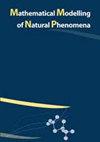Scientific breakdown of a ferromagnetic nanofluid in hemodynamics: Enhanced therapeutic approach
IF 2.1
4区 数学
Q2 MATHEMATICAL & COMPUTATIONAL BIOLOGY
引用次数: 45
Abstract
In this article, we examine the mechanism of cobalt and tantalum nanoparticles through a hybrid fluid model. The nanofluid is propagating through an anisotropically tapered artery with three different configurations: converging, diverging and non-tapered. To examine the rheology of the blood we have incorporated a Williamson fluid model which reveals both Newtonian and non-Newtonian effects. Mathematical and physical formulations are derived using the lubrication approach for continuity, momentum and energy equations. The impact of magnetic field, porosity and viscous dissipation are also taken into the proposed formulation. A perturbation approach is used to determine the solutions of the formulated nonlinear coupled equations. The physical behavior of all the leading parameters is discussed for velocity, temperature, impedance and streamlines profile. The current analysis has the intention to be used in therapeutic treatments of anemia because cobalt promotes the production of red blood cells since it is a component of vitamin B12, this is in addition to having tantalum that is used in the bone implants and in the iodinated agents for blood imaging due to its long circulation time.铁磁性纳米流体在血流动力学中的科学分解:增强的治疗方法
在本文中,我们通过混合流体模型研究了钴和钽纳米颗粒的机理。纳米流体通过具有三种不同结构的各向异性锥形动脉传播:会聚、发散和非锥形。为了研究血液流变学,我们采用了威廉森流体模型,该模型揭示了牛顿和非牛顿效应。利用润滑方法推导出连续性、动量和能量方程的数学和物理公式。该公式还考虑了磁场、孔隙率和粘性耗散的影响。采用摄动法确定了所建立的非线性耦合方程的解。讨论了速度、温度、阻抗和流线剖面等主要参数的物理行为。目前的分析旨在用于贫血的治疗,因为钴是维生素B12的一种成分,可以促进红细胞的产生,此外还有钽,由于其循环时间长,用于骨植入物和用于血液成像的碘化剂。
本文章由计算机程序翻译,如有差异,请以英文原文为准。
求助全文
约1分钟内获得全文
求助全文
来源期刊

Mathematical Modelling of Natural Phenomena
MATHEMATICAL & COMPUTATIONAL BIOLOGY-MATHEMATICS, INTERDISCIPLINARY APPLICATIONS
CiteScore
5.20
自引率
0.00%
发文量
46
审稿时长
6-12 weeks
期刊介绍:
The Mathematical Modelling of Natural Phenomena (MMNP) is an international research journal, which publishes top-level original and review papers, short communications and proceedings on mathematical modelling in biology, medicine, chemistry, physics, and other areas. The scope of the journal is devoted to mathematical modelling with sufficiently advanced model, and the works studying mainly the existence and stability of stationary points of ODE systems are not considered. The scope of the journal also includes applied mathematics and mathematical analysis in the context of its applications to the real world problems. The journal is essentially functioning on the basis of topical issues representing active areas of research. Each topical issue has its own editorial board. The authors are invited to submit papers to the announced issues or to suggest new issues.
Journal publishes research articles and reviews within the whole field of mathematical modelling, and it will continue to provide information on the latest trends and developments in this ever-expanding subject.
 求助内容:
求助内容: 应助结果提醒方式:
应助结果提醒方式:


